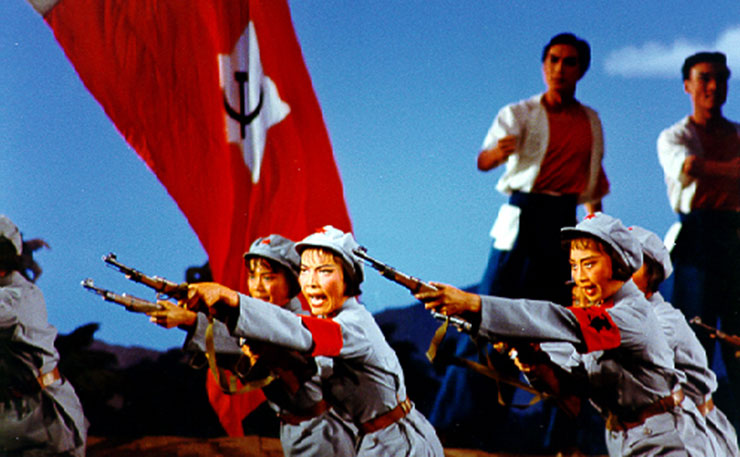After a lifetime of confusion Liz Conor finally understands the Battle that is Ballet. Here’s her review of the perplexing and stunning ballet that is the Red Army Detachment of Women.
The candlestick sat on the bare floor while two aging Ballerinas, their faces yanked back by tight buns, appraised the child snootily. She was required to make-up a dance based on the candlestick for her Ballet exam. Not being terribly au fait, at 5 years, with conventions in the dance cannon around candlesticks she squatted next to it, forming an unshapely pink bundle, reached out her plump hand inquisitively and, entirely devoid of port de bras, squeezed the waxy wick. Having displayed no intention of Brisé-ing let alone jumping over the portentous prop, the Ballerinas summarily sent her out to her mother.
So a review of a ballet performance might be a bit of a stretch. I can hardly pass for an authority on Ballet having failed my first and last exam for neglecting to actually dance. I still have no clue what the hell they’re doing up there. But there was more to the concert I saw last week than Ballet. So much more.
The Red Detachment of Women, adapted from the 1964 movie, is an icon of the cultural revolution whose title alone ought to strike palpitations into the heart of any US Petty Officer currently patrolling the South China Sea.
When Kissenger got Nixon to China (an entire year after Gough) he’d forewarned his POTUS that “your visits with the Chinese will be totally unlike any other experience you have had. The drama and colour of this state visit will surpass all your others … You will have to resist being seduced by the charm of the hosts.”
The drama and colour started outside where we found ourselves on the wrong end of a protest. ‘Shame China!’ one man lunged. ‘China Lies!’ and his compatriots nodded mutely. Unaccustomed to being targeted by protestors we politely took their pamphlet which draws a fantastic link between the beheadings of ISIS and Chinese Christian missionaries in 1934 along with Nazi propaganda to arraign the Chinese Communist government as terrorists and the ballet as terrorist propaganda.
Inside the sets were indeed so saturated with colour they strobed and pulsed – unless the pre-drinks had been spiked with LSD. Certainly an altered state was apposite for this was propaganda trowelled on like the makeup at end of year ballet concerts, and every bit as surreal.
Table tennis players had brokered the ‘breakthough’ for Nixon’s world headlining visit (but we know he was just trying to show up Gough). A formation of en pointe lissome girls jabbing rifles and pistols at the audience carried off his rabid anti-communism like wafting cherry blossoms. What wonders cultural diplomacy can do.
Tibet? The world had been more rattled by Korea and was at this point in time condemning the Bangladesh Liberation War for the systematic genocidal rape of Bengali women by a militia of Pakistani appointed religious radicals. Meanwhile North Vietnam feared Nixon’s visit would broker a deal that disadvantaged them.
As Antonia Finnane explains, when the Ballet premiered in ’64, China had been at war with India, was alienated from Russia, had just set off its first successful atomic test, and was still unrecognized by the US.
The chaos of the Great Proletarian Cultural Revolution was in full swing when Whitlam and Kissenger saw the ballet in ’71 and ’72 – Mao’s deployment of infamous Red Guards to purify the ‘revisionist’ counter-revolutionary ranks of the party. Mostly kids they were then hung out to dry when in ’71 Mao imposed a military dictatorship to restore order over the mayhem. Over two-thirds of the 2 million death toll were exacted by the PLA.
None of which would seem to inspire a frolic of double pirouette on pointe through a meadow of white lillies. By interval I had to ask my Chinese companion why on earth the Chinese had adopted this most Western of art forms (its origins are in the Italian Renaissance courts of the 15th and 16th centuries) to express the revolutionary fervor of the 1930s peasant uprising. It was the soviet influence she replied.
But she was watching more closely for the symbolism of the Red Army Girl Type, already by the Ballet’s inception in ’64 both a nationalist icon and a figure of exotica for the West.
It is the disciplinary erotics of war on full display in this ballet. The sexual vulnerability of the heroine Qionghua opens the ballet – she is shackled to a post in pink silk pyjamas. She escapes her tyrannous overlord, is recaptured and beaten into a coma. Her fitted uniform and capped bob enfold her into a formation – nothing new to ballet – but of emphatically nodding, fist pumping, resolute girl soldiers, fired by the glory of the revolution, and particularly of the newfound liberation of women to divorce, work, and generally resist concubinage with machetes and bayonettes.
There are some startling and endearing omissions: no one falls in love, more the point no one dies for falling in love. The Party Representative, Hong Changqing, would seem a perfect love prospect, but regrettably he is martyred on a pyre. It is, however, Qionghua’s emotions that drive the narrative. Not love, but revenge leads her detachment back to her persecutor’s house and coconut field, where he and his lackeys are smited through a highly creative interpretation of guerilla ballons, grande cabrioles, and en dehors.
When the lush velvet curtains raised for scene four in the endometrial chamber of the State Theatre, a few titters rose from the audience. The cadre of Red Army Girls were seated cross-legged and bolt backed in the outdoor camp before a board emblazoned no doubt with ‘DISCIPLINE’.
But a hush of awe descended when the entire troupe rushes the enemy at night bathed in the red light of battle in a single file of ferociously extended Tour jetés. If China is touring with this ballet to express their might on the world stage, this advance of the detachment might even disquiet Trump.
DISCIPLINE is at the heart of this production. It conjoins ballet with military mastery. Ballet is the cloaking of sheer grunt by grace, athleticism by poise, strength by suppleness. It is an elaborate disguise of human stamina, acrobatics and tensile potency and dancers of this caliber have said it’s the closest they come to flying.
And it all comes to the crunch in the hobbled toes of the Ballerinas. The sylph-like weightlessness created by pointe technique would seem to stand alone in the torments perpetrated against women in the name of beauty until you consider Chinese footbinding. In the Red Detachment of Women the balletic gesture camouflages the bloodied toecaps of both soldiers and ballerinas.
Both formations of art, both troupes of disciplined bodies are saturated in gendered ideologies of kitsch propaganda. At first jarring in the Red Detachment, ballet and battle in fact make perfect sense together. A kind of innocence and malevolence about propaganda accompanies the world tour of this Chinese communist ballet. It is quixotic, mesmerizing, rousing, tin-eared, bemusing and a spectacle to behold.
Donate To New Matilda
New Matilda is a small, independent media outlet. We survive through reader contributions, and never losing a lawsuit. If you got something from this article, giving something back helps us to continue speaking truth to power. Every little bit counts.





